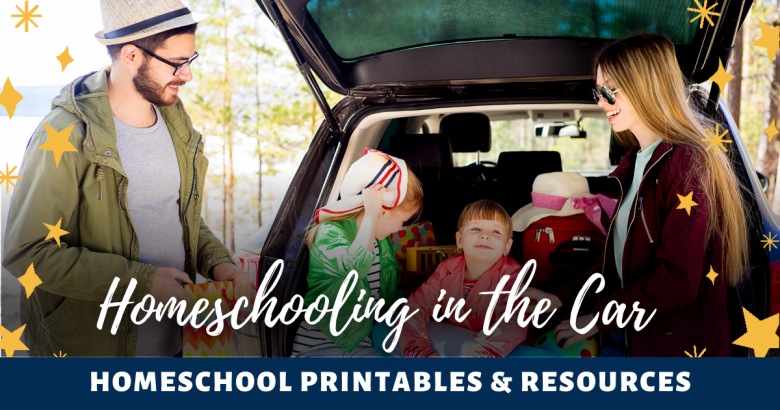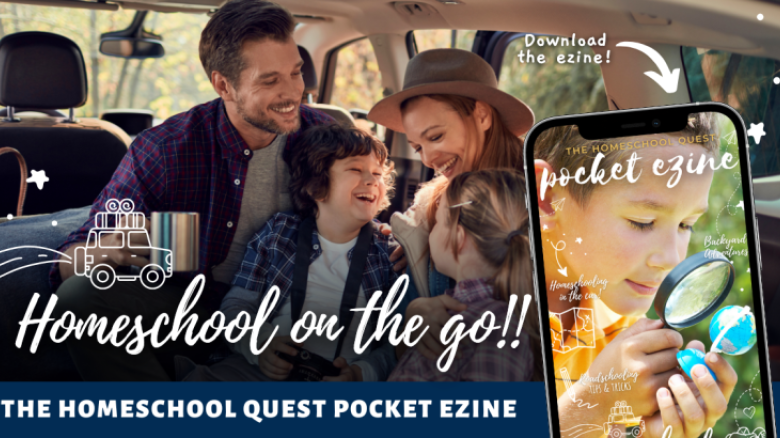By Kelli Laxson
Road schooling can present opportunities for hands-on, experiential learning that is difficult or impossible to match close to home. When you leave the familiarity of your usual surroundings, you anticipate exciting experiences, novel landscapes, new foods, historical sites, and natural wonders. However, on the journey toward each stunning destination, you will spend seemingly countless hours sitting in a moving vehicle.
A couple of years ago, our family drove from Washington to Florida and back, twice in one year. That’s roughly 50 hours of drive time each way.
Even if stopping frequently at attractions along the way, there’s a lot of time to fill between adventures. Rather than perceiving the drive time as an obstacle, we began to see it as an opportunity.
Fifty hours with minimal distraction and no other obligations seems like a good time to assign your homeschoolers some reading, workbooks, writing, or educational games on a tablet.
Though it’s possible for your children to do such desk work, being in a vehicle poses some challenges, such as: cramped space, inadequate lighting, pencils that fall under the seat, and headaches or motion sickness from reading in a moving vehicle.
Given all the unique educational opportunities inherent in a long car ride, you might want to save the more traditional book work for another time.
Look Out The Window
Perhaps the most obvious educational opportunity while driving is simply looking out the window. Traveling across the country presents opportunities to observe and discuss different landscapes, landforms, climates, and vegetation.
From our home in the rainforest of the Pacific Northwest, through the badlands of South Dakota and the prairies of the Midwest, to the swamps of Florida, our child witnessed first-hand the contrast of landscapes across America.
From the car, we saw volcanoes, waterfalls, canyons, mountains, prairies, cornfields, swamps, and cities. Each prompted an extended conversation on geology, climate, history, geography, and ecology. For example, a mountain inspires discussions on tectonic plates, rain shadows, and erosion.
Then, of course, there’s the wildlife. On our travels, we’ve seen alligators, prairie dogs, bison, pronghorn, bighorn sheep, bald eagles, spoonbills, and bears, in their native habitat—all from our car! Seeing such rare creatures is exciting for anyone, but especially so for children, in whom it can spark an interest that could grow into a passion or even a career.
Nightfall offers new discussion topics: constellations, planets, moon phases, light pollution, the rotation of the Earth, electricity, and more. As adults, we may be numb to the wonders right outside our windows, but if we engage with our children to explore these sights, we can help them to develop a sustained appreciation for the world and its wonders.
You don’t need a background in the natural sciences; simply sharing what you do know and allowing your child to hypothesize will encourage a curiosity that can be researched more thoroughly later.
And don’t forget that you can supplement your car-schooling with podcasts; there's at least one for any topic.
Look Inside Your Car
There is another world of educational opportunity inside the vehicle itself. The clock, speedometer, odometer, navigation app, climate control, fuel gauge, and more offer tangible math lessons.
For early learners, use these tools to work on basic number sense. For older children, word problems become reality, as you have them calculate your arrival time, accounting for speed, distance, and time zones.
Your children can even check their answers against a real-world result. Mile markers and highway signs offer even more variables for your word problems.
Look For Literacy
What about the centerpiece of all elementary education: literacy? For younger children, it may be as simple as reading song titles as they pop up on the vehicle’s display. Just as you do at home, work with them on longer words, when necessary.
For slightly older children, have them read billboards and highway signs aloud. The time limit imposed by a vehicle moving 80 miles per hour can make it a game. Another fun challenge is to have them tally the occurrences of common billboard terms, like “insurance” or “barbecue”, and see which is most common that day.
A family spelling bee is also a car-friendly activity that doesn’t necessarily require any resources. Challenge each other, because it’s always more fun when parents play too!
Families can also devise their own word games; our family plays grammar games, like giving our child a sentence and having her identify parts of speech or figure out what punctuation should be used.
Look At Road Signs
Even road signs for attractions that you don’t intend to visit can inspire learning. Passing by a battlefield, the birthplace of a historical figure, a museum, or a park site can lead to discussions of important events in history, literature, and scientific discovery.
It can also provide ideas for future road trip destinations! On our travels, we also saw road signs for geographical features such as rivers, time-zone changes, continental divides, and state boundaries.
For each new state we entered, we referenced an atlas for information like the capital and the state’s official flower, tree, and bird. A nondescript sign for the 45th parallel introduced new vocabulary and concepts like ‘latitude’ and ‘equator’.
Look To Each Other
Learning does not need to be as explicit as described above. Our child would be content to chat all day long. Without the distractions of your daily routine, those long hours of driving are an ideal chance to have open-ended conversations with your child(ren).
This follows our general approach to homeschooling in the car: do not take anything for granted.
A mountain isn’t just a mountain; it’s a discussion about rain shadows.
An odometer doesn’t simply tell you how many miles you’ve traveled; it provides variables for algebra equations.
A billboard isn’t merely an eyesore; it’s a spelling lesson.
While it might be tempting to utilize travel time to keep up with the homeschool curriculum you usually follow, endless hours in a car with your child(ren) is more than time to do bookwork; it’s an opportunity to fill their minds and to grow your relationship with them.
By Kelli Laxson
Read More!
- Log in to post comments




